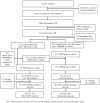Outcomes of HIV-positive patients with non-tuberculous mycobacteria positive culture who received anti-tuberculous treatment in Botswana: Implications of using diagnostic algorithms without non-tuberculous mycobacteria
- PMID: 32530972
- PMCID: PMC7292360
- DOI: 10.1371/journal.pone.0234646
Outcomes of HIV-positive patients with non-tuberculous mycobacteria positive culture who received anti-tuberculous treatment in Botswana: Implications of using diagnostic algorithms without non-tuberculous mycobacteria
Abstract
Background: Patients with non-tuberculous mycobacteria (NTM) or Mycobacterium tuberculosis (MTB) pulmonary disease may have similar clinical presentation. The potential for misdiagnosis and inappropriate treatment exists in settings with limited testing capacity for Xpert® MTB/RIF (Xpert), phenotypic culture and NTM speciation. We describe treatment outcomes among people living with HIV (PLHIV) who received anti-tuberculosis treatment and were found to have NTM or MTB positive sputum cultures.
Methods: PLHIV attending one of the 22 participating HIV clinics, who screened positive for ≥1 tuberculosis (TB) symptoms (cough, fever, night sweats, or weight loss) were asked to submit sputa for culture and speciation from August 2012 to November 2014. The national intensified TB case finding algorithms were followed: initially symptomatic patients were evaluated by testing sputum samples using a smear (smear-based TB diagnostic algorithm) and, after GeneXpert instruments were installed, by testing with Xpert (Xpert-based TB diagnostic algorithm). Within the study period, TB diagnostic algorithms used for MTB did not include screening, diagnosis, and management of NTM. Despite MTB negative culture, some symptomatic patients, including those with NTM positive culture, received empirical anti-TB treatment at the discretion of treating clinicians. Per the World Health Organization treatment outcomes classification: died, treatment failure or loss-to-follow-up were classified as unfavorable (unsuccessful) outcome; cured and treatment completed were classified as favorable (successful) outcome. Empiric treatment was defined as initiating treatment without or before receiving a test result indicating MTB. We compare treatment outcomes and characteristics among patients with NTM or MTB positive culture who received anti-TB treatment.
Results: Among 314 PLHIV, who were found co-infected with TB, 146 cases had microbiological evidence; and for 131/146 MTB positive cultures were reported. One-hundred fifty-two of the 314 were clinically diagnosed with TB and treated empirically. Among those empirically treated for TB, 36/152 had culture results positive for NTM, and another 43/152 had culture results positive for MTB, reported after patients received empirical anti-TB treatment. Overall, MTB positive culture results were reported for 174 (131 plus 43) patients. Treatment outcomes were available for 32/36 NTM and 139/174 MTB; unfavorable outcomes were 12.5% and 8.7% for NTM and MTB, respectively, p = 0.514, respectively. For 34/36 tested NTM patients, all Xpert results indicated 'no MTB'. Among patients who initially received empiric anti-TB treatment and ultimately were found to have MTB positive culture, the unfavorable outcome was 11.8% (4/34), compared to 12.5% (4/32) of patients with NTM positive culture, Fisher's exact test p = 1.00.
Conclusions: While the higher unfavorable outcome was non statistically significant, the impact of inappropriate treatment among NTM patients should not be overlooked. Our findings suggest that Xpert has the potential to rapidly rule-out NTM and avoid sub-optimal treatment; further research is needed to evaluate such potential.
Conflict of interest statement
The authors have declared that no competing interests exist.
Figures
References
-
- Agizew T, Basotli J, Alexander H, Boyd R, Letsibogo G, Auld A, et al. (2017) Higher-than expected prevalence of non-tuberculous mycobacteria in HIV setting in Botswana: Implications for diagnostic algorithms using Xpert MTB/RIF assay. PLoS ONE 12(12): e0189981 10.1371/journal.pone.0189981 - DOI - PMC - PubMed
-
- Brode S.K, Daley C.L and Marras T.K. The epidemiologic relationship between tuberculosis and nontuberculous mycobacterial disease: a systematic review. Int J Tuberc Lung Dis. 2014. - PubMed
-
- Adikaram CP: Overview of nontuberculosis mycobacterial lung diseases Mycobacterium—Research and Development. IntechOpen, 2018. 257–286.
Publication types
MeSH terms
Substances
Grants and funding
LinkOut - more resources
Full Text Sources
Medical


